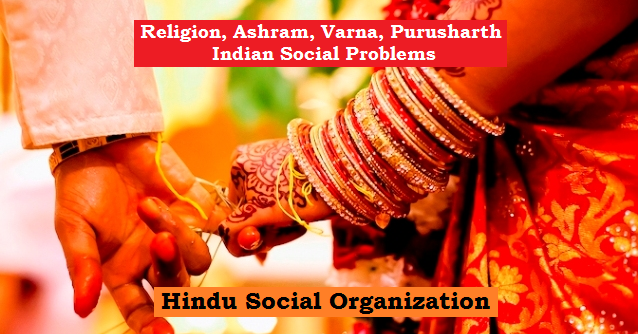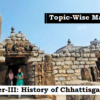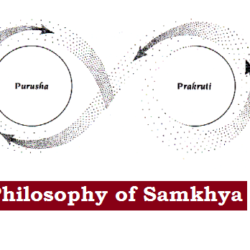
Traditional Hindu social organisation was primarily governed by religion i.e. Hindu Dharma. The social relations were defined in terms of religious obligations. Various means were used of enforce religious values and norms.
A life of Dharma stands for performance of duties as per the natural or cosmic laws (Rta) related to four stages of life (Rna) and to fourfold purpose of life (Purushartha). Following the dharma leads to prosperity and well being of the whole society.
Components of Dharma:
- Spiritual (Rta):
- Eternal, cosmic and moral order
- Eternal and inviolable laws of nature
- It is the path of righteousness and reasoning leads to right behaviour
- Vedic Gods are guardians of Rta and are angry when not followed
- Social (Rna):
- It implies social morality, a sense of gratitude for whatever one receives from his fellow beings
- Four stages of life (Ashram System): Brahmacharya (Student), Grihastha (Householder), Vanaprastha (Retired), and Sanyas (Renounced)
- Every stage has duties which contributes to the social stability
- An individual has 3 Rna: Rishi Rna (debt of teachers), Pitra Rna (debt of ancestors) and Dev Rna (divine debt)
- Some Vedic literature also talks about a 4th Rna– Manushya Rna (debt for humanity)
- Subjective (Purushartha):
- They are supreme ends (aim or goal) of a good life
- Good life consists of: Dharma (moral duty), Artha (economic prosperity), Kama (pleasure), and Moksha (salvation)
Ashram System
The Ashram system was prescribed for the achievements of the values included in the concept of Purushartha. Under the Ashram System, human life was divided into four stages; every stage has social responsibilities and duties which contribute to the social stability.
Four Stages of Ashram System:
- Brahmacharya Ashram: Student life
- He enters the Gurukul to receive education
- It is the life of discipline
- His life is regulated in such a manner that there is a balanced development of personality.
- His duties include the life of austerity, service to the teacher, reverence and respect.
- Grihastha Ashram: Household life
- This stage starts with his marriage ceremony at the age of about 25 years.
- He is supposed to carry out duties of his family and society (e.g. social life, compassion, donation, etc) as well.
- This stage is mainly meant for the satisfaction of man’s material and emotional urges.
- Vanaprastha Ashram: Retired life
- After completion of his household and social duties, it starts at about 50.
- His gradual withdrawal from worldly affairs starts.
- It is a life of self-control and friendliness and charity to others; sharing wisdom with others.
- He is supposed to have complete renunciation from the society at the final stage.
- Sansaya Ashram: Renounced life
- It is complete withdrawal from the world at the age of about 75.
- He is expected to devote his entire time towards meditation towards spiritual pursuit.
- Devotion and mediation lead to the ultimate aim of Hindu philosophy- Salvation (Moksha).
Varna System
In Hindu social organization, every political and economic activity takes place within the context of a Hindu view of life. The Varna System is dividing the members of the traditional Hindu society was an ideological construct where each varna is associated with a particular occupation.
Literally ‘Varna’ means colour and originates from the world ‘Vri’ meaning the choice of one’s occupation.
The Four Varna are:
- Brahman (Priest)
- Kshatriya (Warrior)
- Vaishya (Trader)
- Sudra (Worker)
Caste System:
‘Jati’ (caste) originates from the root word ‘Jana’ which implies taking birth. Thus, caste is concerned with birth.
Caste is that extreme form of social class organization in which the position of individuals in the status hierarchy is determined by descent and birth. This is similar to the hierarchy among varna, however, Varna and Caste are two different concepts. It refers to actual endogamous groups (community) in a Varna.
The higher castes claimed to have ritual, spiritual and racial purity which they maintained by keeping the lower castes away through the notion of pollution.
Features of Caste System:
- Hierarchical positions of castes: At the top of this hierarchy is the Brahmin caste and at the bottom is the untouchable caste.
- Hereditary status and occupation: People from one caste follow the same occupation in mainly in rural areas. Though, this has started blurring and caste based occupation is fading gradually.
- Endogamy with Gotra exogamy: The members of a caste or sub-caste should marry within their own caste or sub-caste generally. Gotra exogamy is also maintained in each caste i.e. prohibition of marriage within the same Gotra.
- A particular family name: Every caste has a particular name though which we can identify it. Sometimes, an occupation is also associated with a particular caste.
- The concept of purity and pollution: The higher castes claimed to have ritual, spiritual and racial purity which they maintained by keeping the lower castes away through the notion of pollution.
Varna Vs Caste
| Varna | Caste |
| 1. Varna is concerned with one’s colour or occupation. | 1. Caste is concerned with birth. |
| 2. Varna’s are only four in number i.e. Brahmin, Kshatriya, Vaishya and Sudra | 2. Castes are very large in number. Castes also have many subdivisions known as sub-castes. |
| 3. Mobility pattern Varna’s are relatively flexible with one’s talent and knowledge, compared with the castes. | 3. It is based on rigid principles and mobility is less. |
| 4. Varna system is free from socio-economic and political disabilities | 4. Imposes many restrictions on the members. |
Purusharth
Purushartha is a Sanskrit word that can be translated as the “object of human pursuit” or “goals of man.”
It is related o the aims a person should have in his lifetime in order to have a good life and to achieve the ultimate goal of Moksha.
Four Purusharthas: Good life consists of
- Dharma (moral duty)
- Artha (economic prosperity)
- Kama (pleasure)
- Moksha (salvation)
Dharma being the characteristic of human beings, leads to achievement of other goals with the ultimate goal of Moksha. All are intimately connected with each other, Dharma accompanies Artha, Artha means to Kama, Kama leads to Moksha. Dharma without Moksha is mere rituals, Artha without Dharma is greediness, Kama without Artha is lust.
Significance of Purusharth:
- It is closely linked with Ashram System and helps the human activities lead towards the ultimate aim of Moksha.
- It intends to guide one to achieve a high standard of living and life.
- It guides one to follow his moral duties while fulfilling his material prosperity and desire.
- It gives the ultimate air for human existence.
Indian Social Problems
Modern Indian is facing many social problems that have their roots in our socio-cultural traditions, demographic changes, colonial past and cultural-political processes.
Some of the major social problems of modern India are:-
- Poverty
- Racism and Communalism
- Unemployment
- Female Foeticide
- Honour Killing
- Gender Discrimination


 Home
Home Syllabus
Syllabus Contact Us
Contact Us








